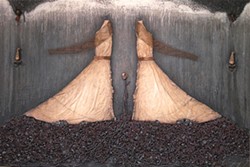For her exhibit Between Worlds, Brenda Stumpf has created paintings, sculptures, charcoal sketches, ink drawings and elaborately dimensional works combining layers of acrylic, gesso, wire, leaves, flowers, fabric and lace. But although the media that she employs swings from one end of the pendulum to the other, the ideas she communicates at Box Heart Gallery are strongly consistent. Particularly prevalent is the theme of ends leading to beginnings, growth emerging from decay and, ultimately, life following death.
The smallest works are the only ones revealing purity of color, blood-red ink scrawled on paper, scratches clean and bright and delicate, vivid tendrils clambering over small pages. A duet of sketches represents a longer series titled “Fifty Days at Niflheim” — lightless charcoal, chalk, pastel and pencil dense and dark and still but full of movement, hinting at mountains considering the possibility of volcanos, waves debating whirlpools.
A handful of paintings are centered upon absence, giving up even the ghost to present the shadow and space left behind. Three similar pieces are a trinity, each centered upon a woman no longer present, providing a glimpse of the missing through the echo of her form. Colors of earth, blood and rust drip from a halo of stained and murky ivy, waving and wafting in an invisible breeze so we might envision a complete being through the mere suggestion of her hair floating on the wind.
Another handful of large-scale mixed-media works on canvas are the showstoppers, each dominating an entire wall of the small gallery, and facing each other. “Strewing of the Besen” splits a yellowed vintage slip up its torso from the hem, the rift left by the imagined shears overflowing with desiccated roses. The frock in “Didymous (The Twins)” is fully cleaved from stem to stern, pulled open above a junkpile of twisted brambly wires and mechanical tentacles, petrified leaves and fossilizing shells. But from this apparent wreckage has sprung a single rose, strong and proud and reaching through and between that which has been torn apart.
The undercurrent in these works is the capability for continuance, the chance at a needle of vitality hidden within a haystack of disintegration, the vastness of life and its refusal to be limited. It’s a beauty that’s rough and uneasy, but all the more potent for its challenge.















